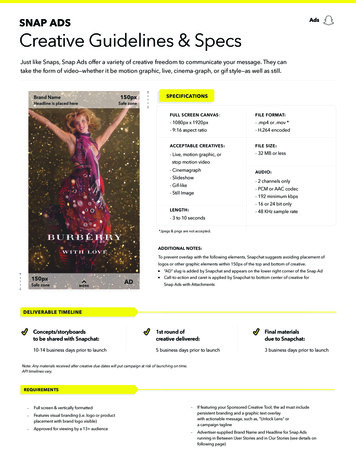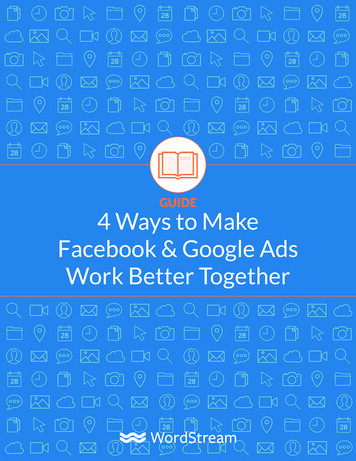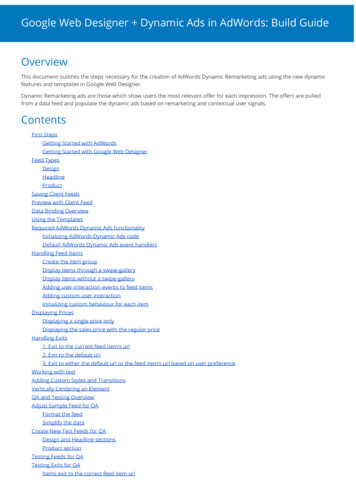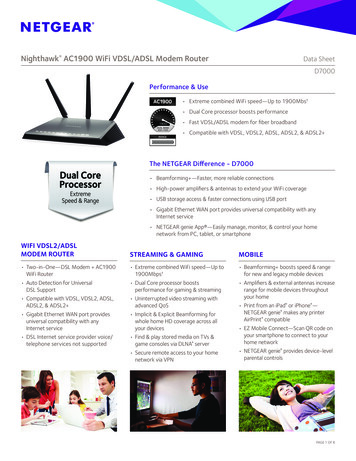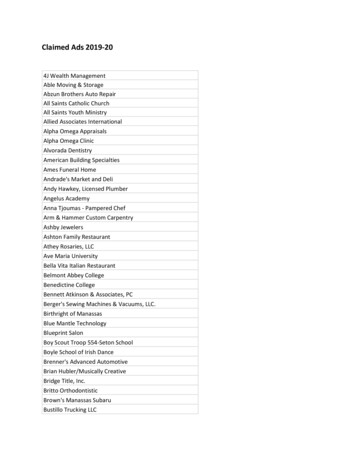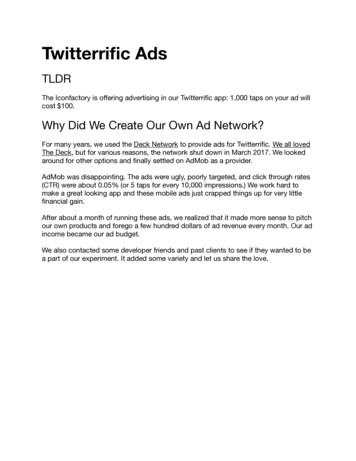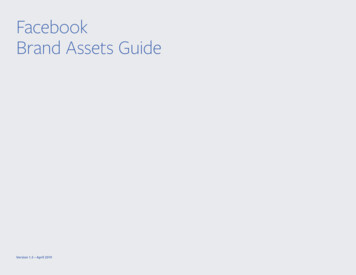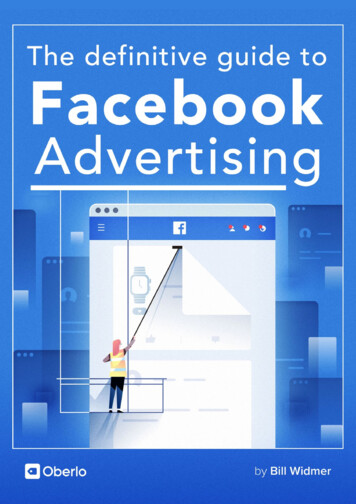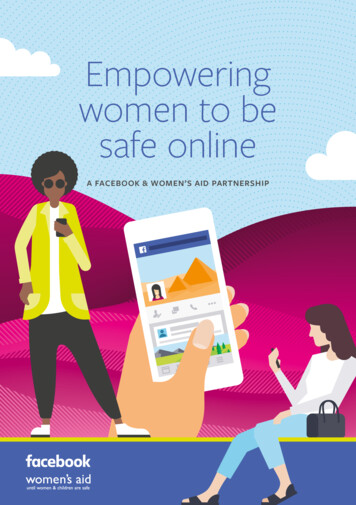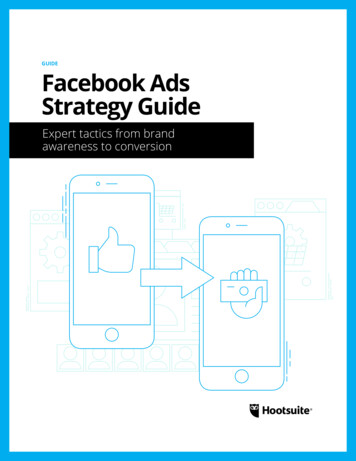
Transcription
GUIDEFacebook AdsStrategy GuideExpert tactics from brandawareness to conversion
Facebook Ads Strategy GuideExpert tactics from brand awareness to conversionFFExpert techniques for taking your ad strategyto the next level2.1%3.9%10.4%40.1%37.7%SnapchatFFCommon ROI metrics advertisers can’tafford to get wrongSlideshareFFCrucial A/B tests every marketer shouldconduct to lower costsPinterestFFThe specific ways you can target andretarget audiencesLinkedInFFHow to use ads efficiently to increaseyour brand’s reachInstagramWhether you’re trying to build brand awareness,increase sales and leads, or do all of the above,Facebook ads can help you reach your businessgoals at every stage of the customer journey. In thisguide, you’ll discover:63.5%Why? Out of Facebook’s two billion monthly users,the average person spends a minimum of 50 minutesa day on one of Facebook’s products—more than anyother network.% of respondentsTwitterBut how hard are these dollars working? Accordingto eMarketer, 96 percent of marketers considerFacebook the most effective social media advertisingplatform based on proven ROI.Social media platforms thatproduce the best ROI accordingto social media marketersworldwide, March 2016Facebook 95.8%Facebook advertising is abooming business with no signof slowing down. Every year,15 million companies spendbillions on Facebook ads.Note: n 456; respondent chose up to 3Source: Social Fresh, “The Future of Social” in collaboration with FirebrandGroup and Simply Measured, April 21, 2016FACEBOOK ADS STRATEGY GUIDE2
Contents4Increase brand awareness using adsLeverage Facebook’s powerful targeting to findand grow your audiences8Target and optimize key audiencesReach the customers most likely to buy13 Testing your ads at scaleSave time and money with strategic testingtechniques16 Optimize your ads like a proOnly run ads where your audience is active19 Measure ad performancePaid social attribution and the metrics youcan’t afford to ignore24 Advanced optimization techniquesGet industry best practices that you canapply to your campaignsFACEBOOK ADS STRATEGY GUIDE3
1 Increase brandawareness using adsLeverage Facebook’s powerful targetingto grow your audienceBefore you earn somebody’s business, you need to gettheir attention. Facebook’s huge user community means yourbrand’s message has the potential to be far reaching—but youcan’t rely on these big numbers to do all the work for you.Only two percent of a brand’s audience actually sees theirorganic posts on Facebook. If you want to drive engagement,traffic, and conversions, you need a combination of paid andorganic Facebook posts.FACEBOOK ADS STRATEGY GUIDE4
Create a BrandAwareness campaignto ensure your ads aredelivered to the peoplemost likely to respond—and to have a higherresponse rate when itcomes to ad recall.ABOVE:Help people find your productsFacebook has features developed specifically to help peoplediscover your products and engage with your business including:1. Brand Awareness Campaigns2. Reach Campaigns3. Unique Ad Formats4. Brand AnalyticsFACEBOOK ADS STRATEGY GUIDE5
Brand Awareness CampaignsBoosting discoverability is the first step towards building a strongbrand and driving sales.Facebook’s brand awareness campaigns let you promote yourbusiness in the place where people find new things—and wherethey’re already in discovery mode.To increase discoverability, select the Brand Awareness objectivein your Facebook ads dashboard. This optimization for brandawareness combines reach and attention to ensure your ads aredelivered to the people most likely to respond - and to have higherad recall.Before you create an ad using the Brand Awareness objective, youshould note: You can find the brand awareness optimization in Ads Manager,which is also supported by Hootsuite Ads Eligible placements include Facebook, Instagram, and AudienceNetwork You can use image, video, slideshow, and carousel ad formats Like other optimized cost-per-thousand-impressions (CPM)bidding types, you’ll be billed by impressionsFacebook Tip: To avoid overspending, use only one placement(Facebook Mobile News Feed, Instagram, etc.) per ad set and seta bid specifically for that placement. The CPM can vary greatlyfrom placement to placement with the same audience, so stickto one location for your Brand Awareness ads.Reach the right audienceIf you want to reach a broad audience, Facebook makes it easy. Usetheir Reach Objective to influence the biggest audience at the lowestcost. (Learn more about it on Facebook’s Brand Awareness page.)FACEBOOK ADS STRATEGY GUIDE6
Boost brand awareness and reachwith eye-catching ad formatsFacebook’s multiple ad formats offer brands a solution for everybusiness goal. When your primary focus is attracting customersat the top of your sales funnel, there are two key ad formats toconsider: Video ads: With 100 million hours of video watched dailyon Facebook, video ads are a powerful way to connect withpeople. Video ads can start playing as soon as they appearin a viewer’s News Feed, so they can engage your audienceimmediately. Slideshows: Create engaging slideshows with your photos injust a few minutes and capture your audience’s attention withmotion. Slideshows give you the power of video without thecost and time associated with production.Measure brand awareness and reachFacebook suggests specific metrics for measuring the success ofyour brand awareness and reach-optimized ads. Estimated Ad Recall Lift (people): A new metric, estimatedad recall lift (people) gives you an estimate of how manypeople are likely to remember your ad after having seen it.It’s calculated by comparing the number of people you reachand the time they spend looking at your ads (attention) withhistorical information about the correlation of attention andreach to ad recall. Brand Performance Metrics: When running a brandcampaign, metrics like reach, video views, and cost per videoview (CPV) help you measure brand awareness, engagement,and the associated cost. These metrics are designed to be abetter benchmark for brand awareness than metrics like clicksand page likes.FACEBOOK ADS STRATEGY GUIDE7
2 Target and optimizekey audiencesReach the customers most likely to buyNot all audiences are created equal, so for best results youneed a comprehensive Facebook ad strategy. Once you havehad engagement with your Facebook content and previous ads,you have powerful data for optimizing your audience targeting.Don’t forget: Always have your conversions setup and goals inmind before launching any campaign.FACEBOOK ADS STRATEGY GUIDE8
Use basic andadvanced demographics todeliver highly targeted adsto different audiences.ABOVE:Track conversions and optimize adswith the Facebook PixelThe Facebook Pixel’s targeting and retargeting capabilities can helpyou get the most out of your social ad budget.A Facebook pixel—a line of code that you place on your website—helps brands track conversions from Facebook ads, optimize adsbased on collected data, build targeted audiences for future ads,and retarget to qualified leads.It places and activates cookies to track users as they interact withyour site and Facebook ads.See our blog post The Facebook Pixel: What It Is and How to Use Itfor more detailed information.FACEBOOK ADS STRATEGY GUIDE9
Target specific devicesAs you build your audience targeting strategy, you must considerthe devices (mobile versus desktop) that your target audience ismost active on.Device-specific targeting allows you to initially target ads to onedevice as part of raising brand awareness, then target a differentdevice to drive conversions, and again to complete the sale. Thissets you up for success at every stage of the customer’s buyingjourney.Identify the type of device most likely to lead to conversionsdepending on your campaign goals. Consider your target audienceand the devices they would be most likely to use based on theirdemographics and behavioral patterns.For example, if you are trying to achieve app downloads, considertargeting mobile devices exclusively, since this is where yourpotential customers are most active and will be completing thedesired conversion.Drive sales with custom audiencesWith Hootsuite Ads, you can use your existing audience data tocreate custom and lookalike audiences that will help you effectivelydrive revenue.Custom audiencesCustom audiences let you find specific groups of people to targetbased on a set of data (such as email lists, data from CRM systemssuch as HubSpot or Salesforce, and people who have liked yourFacebook Page).Use a custom audience when you want to: Reach people who visited a product page but didn’t complete apurchase (to encourage them to go back and do so) Create an audience of everyone who’s visited your website inthe past 30 daysFACEBOOK ADS STRATEGY GUIDE10
Lookalike audiencesOnce you’ve figured out what works for your custom audiences,you can create lookalike audiences from this data and show themsimilar campaigns and offers.To begin, identify your top engagers. See who’s liking your posts,leaving comments or feedback, writing reviews of your brand,and sharing your page with their Facebook friends. These are thepeople you want to replicate in your lookalike audience when itcomes to your Facebook ads.To ensure you’re targeting the right people, make a list of your topconverting customers based on transaction value, engagementwith your brand, and lifetime value. Ideally you’ll want data fromseveral hundred—or even a few thousand—customers to enterinto Facebook.You want to create brand awareness and reach only for your verybest potential customers—the ones who have the highest lifetimevalue to your brand and will continually come back to purchaseyour products.Use a lookalike audience when: Your main objective is brand awareness and acquiringnew customers You want to grow in a new international market (for example,by creating a lookalike audience based on your local customers)Suggested reading:Find out how children’s education brand Little Passports used lookalike audiencesto achieve 3X customer base growth in six months and realized a 60 percentdecrease in CPAFACEBOOK ADS STRATEGY GUIDE11
Use retargeting to stay top-of-mindwith potential customersIf you’ve ever visited an ecommerce website and had a productad follow you around for days, you know how effective retargetingcan be.Retargeting allows you to reach highly engaged audience memberswho are at the evaluation stage of the buying journey. Thesepeople have interacted with your Facebook Page or website insome way (for example, by putting an item in their cart but notcompleting the purchase), and so have shown engagement levelsoptimal for your business.Retargeting is also effective for cross-device optimization. Forexample, if you are a company with a mobile product, considertargeting everyone who visited your website on desktop in thepast month with a mobile ad featuring a persuasive call to action.When your audience is on the optimal device, they’re more likely toconvert.Formats that are effective for retargeting:Offer adsWhen shown to audiences who are between the evaluation andpurchase stages, offer ads are an effective way to encourageconversion. You can create offer ads for everything from freeshipping on a customer’s first purchase to a deluxe sample of anew product with each order.Offers are a feature that must be enabled. You can find themunder the Ad Set category when creating your Facebook ads.Carousel adsWhen using carousel ads to increase conversions with retargeting,you have a few options. You can use the carousel ads to highlightfeatures that make your product superior, or show a combinationof products or services that will be most relevant to users basedon their past purchase history.Did they buy a new computer from your ecommerce site? Usecarousel ads to show them a wireless keyboard, Bluetooth speaker,laptop stand, and screen cleaner. By showing complementaryproducts, you can both drive further purchases and increase theaverage purchase value.FACEBOOK ADS STRATEGY GUIDE12
3 Testing your adsat scaleSave time and money withstrategic testing techniquesEvery digital marketing strategy requires constantinnovation and testing in order to to achieve better results andstay ahead of the curve especially as Facebook itself releasesnew products and features on a regular basis.The strategies below are some great ideas you can apply toyour current or upcoming campaigns to ensure you get thebest results possible.FACEBOOK ADS STRATEGY GUIDE13
Test differentcombinations of headline,text, images, video, andURL to create topperforming ads.ABOVE:Use A/B testing to find top-performing adsFacebook ads are the perfect venue for learning what resonatesbest with your audience, from format to image style to hashtags tolength of copy and tone of voice. With the data you gather duringtesting you can better predict what ad content will convert.There are many ad components you can test to find out whatworks best for your audience, and with Facebook ads you can doso at scale.Key areas to test include: Text: Test your ad’s length (number of characters), style (aquestion versus a statement), use of emoji, punctuation, andtone of voice.FACEBOOK ADS STRATEGY GUIDE14
Call to action: Try out different ways of asking your audience toengage. For example, you could test whether “buy now” worksbetter than “learn more.” Visuals: Test different images and video, text-only posts versusthose with images, a regular image versus a GIF, images ofpeople or products versus graphs or infographics, and differentvideo lengths.What test should I run first?Headline and image. Because they’re so visible, the headlineand image are key areas for quick testing. You can apply allthe same tests mentioned for text to your article headline anddescription to see what works—and what doesn’t. Format: Test different formats against each other, such ascarousel ads, canvas ads, app install ads, video ads, lead ads,collection ads, slideshow ads, and regular photo ads. Target audience: Test your ads against the different audiencesegments mentioned in the previous two chapters to see whatworks best for your business objectives.Suggested reading:A/B Testing on Social Media: How to Do it with Tools You Already Have5 Surprising Ways to Optimize Your Facebook AdsFACEBOOK ADS STRATEGY GUIDE15
4 Optimize yourads like a proPaid attribution and the metricsyou can’t afford to ignore00:00:00Optimize your mobile app adsFacebook’s App Event Optimization lets businesses run mobileapp install ads to people likely to take a specific action in your app.For example, if you are looking to acquire customers most likely toactually make a purchase within your app, you can select mobileapp install ads optimized for purchases. Or, if you want a user to“add to cart” from in your app you can optimize your mobile appinstall ads for this purpose.FACEBOOK ADS STRATEGY GUIDE16
Take the guesswork out of optimization with Hootsuite AdsOptimize your campaigns in less timeEasily create and test hundreds of Facebook and Instagram adsin minutes, not hours. Get higher conversions through granularcontrol over placement, timing, and custom audiences.Save valuable time and resourcesStop draining your campaign budget on extensive—andunnecessary— trial-and-error testing methods. Use ourexperts’ battle-tested knowledge and expertise to optimize yourcampaigns in less time.Better performance through automationAutomatically boost budgets—or start new campaigns—basedon preset performance triggers. Improve ad performance withautomatic daily recommendations.Use lead ads to collectcontact informationLead ads are another efficient way for businesses to connect withcustomers during the acquisition stage of the buying journey.When Facebook users click on a lead ad, a form pops up. Facebookautomatically fills in this form with as much information aboutthe user as possible (such as name, email address, and phonenumber, if provided), making it easier for users to make a purchaseon both mobile and desktop.As lead ads allow you to gain a customer’s contact information,you can then reach them with relevant email campaigns andretargeted Facebook ads.FACEBOOK ADS STRATEGY GUIDE17
Set up rules in HootsuiteAds to automatically promoteposts based on criteria you specify.ABOVE:To create a lead ad, select the Lead Generation objective whenbuilding your ad. This ad format is especially effective as part of aretargeting campaign for an audience already familiar with yourbusiness, such as past site visitors or those who have watched oneof your videos. This will keep your relevance score and CTR high—and your CPA as low as possible.You can use lead ads to: Offer deals, coupons and offers Simplify newsletter sign-ups Deliver information about new products, events, or updates Connect with prospects who express interest in your businessFACEBOOK ADS STRATEGY GUIDE18
5 Measure adperformancePaid social attribution and themetrics you can’t afford to ignoreYou don’t have to sacrifice on cost to get results.Measuring ad performance is the best way to optimize yourFacebook ads budget effectively.Learn how to get the most out of your ad efforts—and the keymetrics you need to know to measure and prove results.FACEBOOK ADS STRATEGY GUIDE19
The key metrics everymarketer needs to knowWhen it comes to your advertising costs, it’s critical to ensureyou’re spending your Facebook ads budget as efficiently aspossible. The following metrics will help you optimize your addollars without sacrificing any results.Return on Ad Spend (ROAS). This metric refers to the total returnon ad spend from website purchases. This is based on the valueof all conversions recorded by the Facebook pixel on your websiteand attributed to your ads. If you have a purchase standard event implemented on yourwebsite, this metric counts when the Facebook pixel tracks thatevent, attributed to your ads.Website purchases conversion value total spend ROASRelevance score. Your relevance score shows you how relevantyour ad is to your target audience. Facebook prioritizes ads withhigh relevance scores, lowering your CPC and the cost of your ads.Click-Through-Rate. A better click-through-rate will boost yourrelevance score and lower your cost. Improve CTR by usingDesktop News Feed ad placements (which generate higher CTRs),using appropriate CTA buttons, writing simple ad copy, andkeeping your frequency (the number of times a user sees your ad)as low as possible.Cost per Mille (CPM). This is the basic measurement for socialmedia advertising success. Cost Per Mille (or thousandimpressions) is a term used to denote the price of 1,000advertisement impressions on one webpage. For example, if youspent 50 and received 10,000 impressions, your CPM was 5.(Ad spend impressions) x 1000 CPMFACEBOOK ADS STRATEGY GUIDE20
Cost per Acquisition (CPA). Cost per Acquisition, or Cost perAction, describes the amount an advertiser pays when an ad leadsto a sale (or action). For example, cost per action on Facebookmay apply to Page likes, offer claims, mobile app installs, andlink clicks—you select actions that are the most relevant to yourcampaign. This is the best way to measure success if your goal is to haveyour audience take an action beyond a click. This is effective,for example, if you’re trying to get people to download gatedcontent (which requires a form fill), sign up for a webinar, orredeem a code.Cost per Lead (CPL). To report on the return on investment of asocial ad campaign where the goal is lead generation, you need tocalculate the cost to acquire a lead (cost per lead). To determine CPL, divide your ad spend by the number of leadsgenerated during the campaign period. Your most successfulcampaigns will acquire high-quality leads at the lowest cost.Cost per Lead is a variation of a CPA campaign, whereas a leadis a person who is likely to make a purchase or
Pinterest 3.9% Slideshare 2.1% Snapchat Social media platforms that produce the best ROI according to social media marketers worldwide, March 2016 % of respondents Note: n 456; respondent chose up to 3 Source: Social Fresh, “The Future of Social” in collaboration with Firebrand Group and
